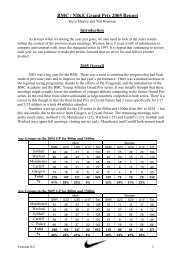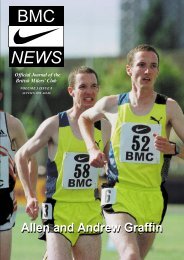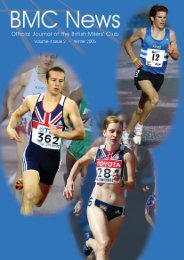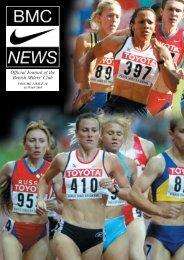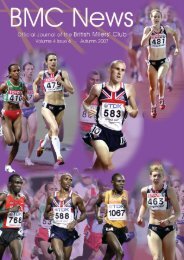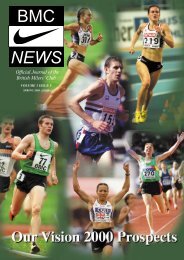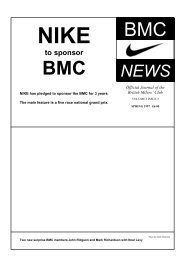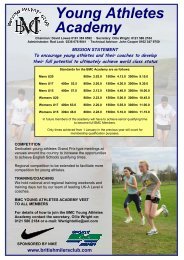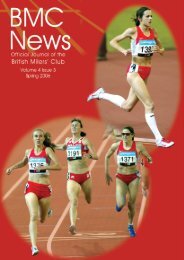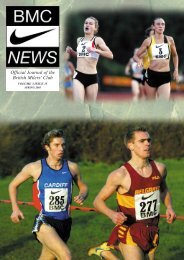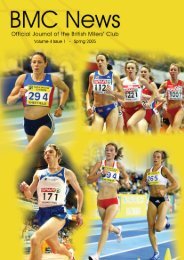BMC April <strong>1999</strong> 7/6/99 9:15 am Page 12Dave Moorcroft - analysis of a championmodified from that previously charted duringhis peak years. Below I have listed a numberof the more important features of his trainingfrom the beginning of 1993 through to the4:02:53 mile.1. Training mileages were reduced by anaverage of 20 mls per week during thewhole of 1993.2. Maximum mileage achieved was 80mlsper week3. The average Jan-March weekly mileagewas only 54 miles due to a number of badcolds causing training to be missed.4. When occasionally feeling very tiredDavid would miss a training session oreven a particular day of training insteadof training through it as he had in the past.5. Due to the reduced training mileages thenumber of days/week with 2 runs wouldtypically be 3 with a maximum of 5.6. A typical training week would stillconsist of 3 repetition sessions but 1 oreven 2 of them would not be performedon the tack.7. Throughout 1993 David very rarely ranthe 3-5 x 1000m (7 mins recovery)session.8. David still maintained the sessions of 4-6x 600m (5 mins recovery) and 4 x 6 x 300fast with several mins recovery.9. The following 2 sessions were regularlyintroduced:a) 10 x 400 (60 secs recovery) andb) 2-3 x 1 mile (3-5 mins recovery).As previously mentioned DavidÕs trainingreally began to improve in both standard andconsistency form the middle of May 93 as theprogress of the 4 x 600m session, in Fig. 5shows. When this improvement was coupledwith an average weekly training mileage of64.5mls during the 6 weeks prior to the4:02:53 it was obvious that David was inexcellent shape. The continued improvementin DavidÕs form during the week followingthis fast mile does suggest that he was ready torun much faster. Unfortunately illnessprevented him from achieving this.Fig. 5 also indicates the times which David ranfor the 4 x 600m training session during hispeak year of 1982. The contrast between the 2curves is quite striking. DavidÕs excellenttimes during his stay in Australasia in Feb 82are obvious as is the time gap of only 4 secsbetween the best and the worst times achievedthroughout the year. As David pointed out tome Òat 40 years of age it is harder to train fora peak of performance and you also lose thetraining effect more quicklyÓ.John Anderson the CoachAdditional facts and items of information1. Date of birth: 28.11.312. Since his early years, John Anderson has been a highly competitive individual who represented Scotland atfootball as a schoolboy and went on to play at the highest amateur level until 1962.3. Was a keen ball games player throughout his early life and also represented Scotland at tennis.4. Only involved in athletics periodically during his school days and occasionally trained for the sprint eventswith Victoria Park Harriers aged 15-17 yrs.5. Was a school physical education teacher until 1964 and it was through this profession that he started tocoach athletics in all events in 1959.6. Was a founder member of Maryhill Ladies AC7. Became a full time AAA National Coach in all events in 1964 and in 1965 was appointed as the first ever fulltimes Scottish AAA National Coach.8. Has coached athletes to International level in all track and field events but has focussed particularly on themiddle and longer distances since the mid 1960 s.9. Prior to meeting David Moorcroft in 1966 John had been sending basic middle distance training schedulesto youth coach and physiotherapist Mick Crossfield at Coventry Godiva Harriers who had requested assistancein this area. At the same time John was also coaching Shelia Carey of Coventry who went on to finish5th in the 1972 Olympic 1500m final and break the UK record.10. John has always based his training methods on a sound physiological foundation and has continued overthe years to maintain his knowledge of the latest developments in sports physiology.11. In the early years as a coach John came to the view that athletes who run slowly for long periods of time inthe absence of speed would ultimately have a greater capability for running quickly if they practicedelements of speed training throughout the year.12. John still believes the above to be true and has extended this view to his belief that in essence all elementsof training should be incorporated to a greater or lesser degree throughout an athlete s annual trainingcycle.12BMC News : <strong>Spring</strong> <strong>1999</strong>
BMC April <strong>1999</strong> 7/6/99 9:15 am Page 131998 UK Merit Rankingsby Peter MatthewsThis is the 31st successive year that I have compiled annual merit rankings of<strong>British</strong> athletes. As usual these are an assessment of form during the outdoorseason. The major factors by which the rankings are determined are win-lossrecord, performances in the major meetings, and sequence of marks.I endeavour to be as objective as possible, but form can often provideconflicting evidence, or perhaps an athlete may not have shown good enoughresults against leading rivals, or in very important competition, to justify aranking which his or her ability might otherwise warrant.I can only rank athletes on what they have actually achieved. Much dependson having appropriate opportunities and perhaps getting invitations for theprestige meetings.Difficulties also arise when athletes reach peak form at different parts of theseason or through injury miss significant competition. Increasingly, also, many ofour top athletes are competing overseas instead of in domestic meetings, whichmakes comparisons of form difficult.Once again it should be pointed out that the rankings are by no means necessarilythe order in which I think the athletes would have finished in an idealisedcontest, but simply my attempt to assess what has actually happened in 1998.I hope that I have not missed many performances, but I would be very pleasedto receive any missing results at 10 Madgeways Close, Great Amwell, HertsSG12 9RU.For each event the top 12 are ranked. On the first line is shown the athletesname, then their date of birth followed, in brackets, by the number of yearsranked in the top 12 (including 1998) and their ranking last year (1997), andfinally, their best mark prior to 1998.The following lines include their best six performances of the year (followed,for completeness, by significant indoor marks indicated by ÔiÕ (although indoorperformances are not considered for the rankings). Then follow placings at majormeetings, providing a summary of the athleteÕs year at the event.MEN 800M1 Andy Hart 13.9.69 (3y, 4) 1:46.36 1997 1:45.71, 1:46.19,1:46.77, 1:47.0, 1:47.0, 1:47.13; 3 BMCBattPk, 3 ECp, 5GhG, 7 BGP, 1 Tooting, 4h ECh, 1 BMCSolihull, 6 WCp,5 CG2 Bradley Donkin 6.12.71 (2y, -) 1:48.25 19961:46.86, 1:47.5, 1:47.65, 1:48.32, 1:48.3, 1:49.01;3 AAA v LC, 4 CAU, 4 Ljubljana, 3 Leeds,2 North, 5 Cork, 7 AAA, 1 BMCWatford,3 Tooting, 6 CG3 Jason Lobo 18.9.69 (3y,11) 1:47.29 19971:47.48, 1:47.74, 1:47.96, 1:48.21, 1:48.23,1:48.41; 2 AAA v LC, 4 Leeds, 2 Istanbul,2 BL1 (3), 4 GhG, 1 AAA, 8 BGP, 6s2 CG4 Grant Graham 27.12.72 (2y, -) 1:49.2 19961:47.85, 1:48.13, 1:48.94, 1:49.25, 1:49.60,1:49.73; 1 CAU, 6 Ljubljana, 1 Scot, 2 AAA,10 BGP, 5h CG5 Paul Walker 2.12.73 (4y, 3) 1:46.4 19971:47.91, 1:48.53, 1:48.68, 1:48.82, 1:48.85,1:49.1; 5 Ljubljana, 2 Stockholm, 2 Scot, 3 Celle,1 BL1 (3), dnf AAA6 Eddie King 26.11.75 (2y, 7) 1:48.22 19971:48.51, 1:48.95, 1:49.01, 1:49.38, 1:49.71,1:49.74; 4 BMCWyth, 2 Leeds, 1 Tonsberg,3 BMCCardiff, 3 AAA, 3h3 CG, BL1: 1,-,-,17 Phillip Tulba 20.9.73 (1y, -) 1:49.88 19971:48.31, 1:48.43, 1:48.71, 1:49.2, 1:49.38,1:50.07; 1 BMCSwindon, 6B Oslo,2 BMCCardiff, 4 AAA, 4 BMCWatford8 Matt Shone 10.7.75 (1y, -) 1:50.2 19971:48.33, 1:48.39, 1:48.6, 1:49.21, 1:49.63, 1:49.8;2B BMCWyth, 5 Leeds, 7B BMCSwindon,1 Welsh, 4 BMCCardiff, 1 IR, 6 AAA,2 BMCWatford, 3 BMCSolihull, BL3: 3,2,1,-9 Chris Moss 17.6.79 (1y, -) 1:49.98 19971:48.43, 1:48.77, 1:49.78, 1:49.92, 1:50.09,1:50.3; 1D BMCWyth, 2B BMCSwindon,1 AAA-J, 3 JIvFS, 6 WJ, 4 BMCSolihull10 Simon Lees 19.11.79 (1y, -) 1:50.5 19971:47.69, 1:48.03, 1:48.88, 1:50.82, 1:51.681 Mid-J, 3 BMCWyth, 2 AAA-J, 6h6 WJ,2 BMCSolihull11? Anthony Whiteman 13.11.71 (3y, 5) 1:47.16 Ô971:47.5, 1:48.4; 1 BL2 (2), 4 BMCBattPk12 Alasdair Donaldson 21.6.77 (1y, -) 1:49.05 19971:48.6, 1:49.18, 1:49.49, 1:49.58, 1:50.0, 1:50.01;1 B.Univs, 1 AAA v LC, 1 BL1 (2), 1 Leeds,1 U23H, 8 Istanbul, 4 Cork, 3 Scot, 2h4 AAA,1 U23D, 1 Cup, 1B BMCSolihullnr James McIlroy IRE 30.12.76 1:51.8 19971:45.32, 1:45.46, 1:45.83, 1:46.7, 1:46.81,1:46.87; 2 Dublin, 1 BMCWyth, 2 BMCBattPk,1 Tallinn, 4 Nice, 1 GhG, 4 ECh, 6 BrusselsHart had a fine year to retain top ranking, and both heand Donkin broke through with pbs at theCommonwealth Games. The overall standard isdepressingly low compared to past glories, but anencouraging feature was the progress of two juniors.Moss beat Lees at the AAA and fared far better at theWorld Juniors, but Lees had better form at the start andend of the season, with pbs for both in the BMC finalsat Solihull. Whiteman could well be higher, but isdifficult to rank - he had two good times, but did notcontest the major races at this distance. One great newtalent emerged - the most exciting <strong>British</strong> middledistancerunner since Curtis Robb, but James McIlroywas snapped up by Ireland, so although he has a <strong>British</strong>passport, he is not ranked.The 10th best of 1:48.31 is better than 1994(1:48.38) but otherwise the worst since 1980.MEN 1,500M / 1 MILE1 John Mayock 26.10.70 (8y, 1)3:31.86 1997 / 3:50.32M 19963:32.82, 3:33.90, 3:34.60, 3:34.71, 3:51.99M,3:53.72M, 3:53.81M, 3:36.74; 1 Hexham,7 St Denis, 2 Bratislava, 3 ECp, 6 Oslo, 10 Rome,2 GhG, 1 AAA, 7 Paris, 2 E.Carr, 10 Monaco,5 ECh, 6 Brussels, 9 GPF, 2 CG2 Anthony Whiteman 13.11.71 (3y, 2)3:32.34 / 3:54.59M 19973:32.69, 3:51.90M, 3:52.09M, 3:35.30, 3:36.78,3:39.52; 4 Bellinzona, 4 Nuremberg, 3 Nice,2 AAA, 3 E.Carr, 7 Zurich, 4 ECh, 3 WCp, 3 CG3 Matthew Yates 4.2.69 (7y, 4)3:34.00 1991 / 3:52.75M 19933:37.04, 3:38.36, 3:38.97, 3:39.5, 3:40.38,3:40.78; 5 Barakaldo, 11 Nice, dnf GhG, 3 AAA,7 Hechtel, 2 BMCWatford, 6 ECh, 2 v USA,12 Berlin4 Kevin McKay 9.2.69 (10y, 3)3:34.59 1997 / 3:53.64M 19943:37.22, 3:40.78, 3:58.52M, 3:43.22, 3:44.42,3:46.18; 4 Hengelo, 5 GhG, 4 AAA, 18 Hechtel,1 Cup, 3 v USA, 5 CG, BL1: 1,-,1,-5 Michael Openshaw 8.4.72 (2y, 6)3:41.38 / 4:03.7M 19973:39.7, 3:57.2M, 3:40.19, 3:43.50, 3:43.60,4:08.33M; 1 CAU, 2 Hexham, 3 BMCBattPk,3 Rhede, 5 AAA6 Neil Caddy 18.3.75 (4y, 8)3:39.1 / 3:55.84M 19963:39.89, 3:58.49M, 3:58.5M, 3:40.9, 3:42.34,3:42.66; 1 BMCWyth, 5 BMCBattPk,2 BMCExeter, 2 Rhede, 4 GhG, 3 WG,3 BMCBath7 Gary Lough 6.7.70 (5y, -)3:34.76 1995 / 3:55.91M 19953:57.58M, 3:40.8, 3:43.33, 3:44.55, 3:44.99,3:46.1; 2B BL1 (2), 2 Lough, dnf BMCSwindon,12 Cork, 8 AAA, 9 E.Carr, 5 WG,3 BMCWatford, 6 v USA8 Spencer Barden 31.3.73 (2y, 9)3:40.10 1997 / 4:02.1M 19963:39.64, 3:58.5M, 3:59.86M, 4:00,73M, 3:44.8,3:46.85; 3 Hexham, 2 Barcelona, 8 GhG, 9 WG,2 BL2 (4), 3 Meilen, 5 BMCSolihull9 Ian Gillespie 18.5.70 (3y, 5)3:39.8 / 3:58.4M 19973:57.6M, 4:01.84M, 3:46.111B BL1 (2), 1 BMCExeter10 Tom Mayo 2.5.77 (1y, -) 3:43.4 19963:41.2, 3:42.33, 4:00.02M, 3:43.98, 3:46.8110 AAA, 4 BMCWatford, 16 Rieti, 4 BMCSolihull11 Phillip Tulba 20.9.73 (1y, -) 3:44.5 19973:59.7M, 3:42.3, 3:42.96, 3:45.0, 3:45.19,4:06.20M; 1 B.Univs, 1 AAA v LC, 8 BMCBattPk,8 Cork, 1 BMCTooting, 11 BMCSolihull12 Christian Stephenson 22.7.74 (1y, -)3:49.90 / 4:02.9M 19974:01.7M, 3:43.85, 4:02.2M, 3:44.82, 3:45.75,3:46.2;3 BMCExeter, 1 Welsh, 2 BMCCardiff, 1 IR,7 BMCBath, 9 CGnr Grant Graham 27.12.72 (0y, -) 3:43.2 19953:41.5, 3:44.09; 6 BMCBattPk, 11 Corknr James McIlroy IRE 30.12.763:59.48M, 3:46.00, 3:49.832 Dublin, 1 ECp 2A, 1 Irish, 2 BMCSolihullM = 1 mile time (1500m times in brackets).Mayock and Whiteman remain 1-2 for the thirdsuccessive year, but it was close with Mayock justhaving the edge, 3-1 on win-loss. Yates and McKayswap places. Openshaw, Caddy and Barden moved upslightly from 1997, but maintained their positionsagainst each other, with Lough returning to split them.The 10th best was 3:41.5 - in 1991 it was 3:41.52, butotherwise this was the worst since 1979.MEN 3,000M (NOT RANKED)Anthony Whiteman 13.11.717:57.59i 95 / 7:57.65 19977:43.61, 8:03.3; 3 ECpBMC News : <strong>Spring</strong> <strong>1999</strong> 13



